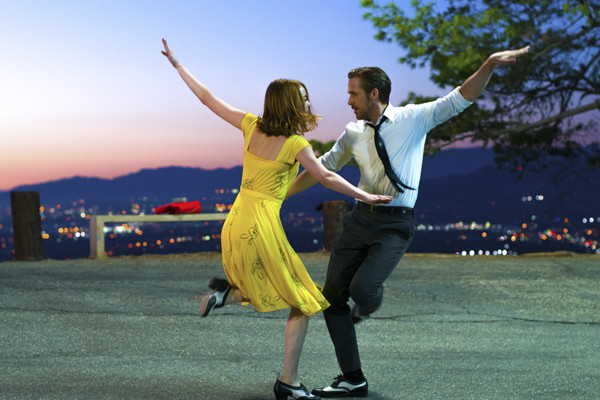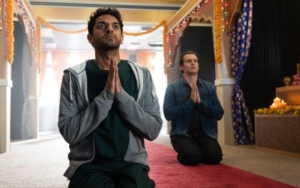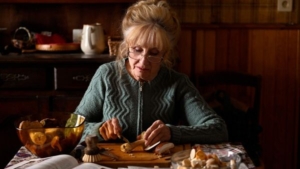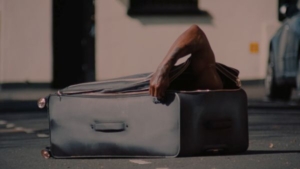Damien Chazelle’s first film, the charmer Guy and Madeline on a Park Bench, was a slender story that covered the break-up and reconciliation between a jazz musician and a waitress, who daydreams via big MGM musical numbers. The film’s raison d’être was a joyous set piece at a fish joint, in which the bar becomes a stage, and Madeline follows in the taps shoes of Ann Miller. Chazelle went on to depict a physiological meltdown set to a jazz combo in Whiplash, and now he returns to his roots, once again combining the ambiance of smoky clubs with MGM’s Arthur Freed unit, though this time with a larger budget; widescreen color; a tighter, snappier script; and two established movie stars in Ryan Gosling and Emma Stone.
The film, screening this week at the Toronto International Film Festival, opens on a bright sunny day with a tracking shot of cars lined up bumper to bumper, stopped dead in their tracks. Any thoughts that this could be related to Jean-Luc Godard’s famous traffic jam from his absurdist Weekend are immediately dispelled when a young, beautiful female driver begins singing “Another Day of Sun.” A man pops out of his car and bursts into the same song, and is joined by dozens of others jumping on their hoods, singing and dancing. Impatience and cynicism be darned, there’s nothing about this sequence or the rest of the film that is hesitant; it’s a full-on musical that aims to entertain, and it more than succeeds.
One stuck commuter, though, remains in her seat talking out loud to herself, not noticing when the traffic begins moving again until her internal reverie is broken by the honking of a motorist roaring past her. For this rudeness, she flips the guy the bird, thus kicking off a contemporary relationship set to the dance step of another era, between Mia, an actress on the audition treadmill (who was rehearsing lines in the car), and an adamantly old-school jazz pianist, Sebastian. While waiting for any break, Mia works as a barista on the Warner Bros. backlot, as Sebastian tinkles the ivories at a restaurant, whoring himself (or so he thinks) by playing the manager’s playlist.
Though the narrative is built around razzle-dazzle production numbers, the film is not a one-trick pony. The connecting sequences between numbers are also light on their feet, with sharp dialogue and effortless chemistry between the two leads, and Chazelle maximizes the flirtation and the will-they-or-won’t-they suspense leading up to the couple’s first kiss. Part of the film’s magic relies on the actors expressing themselves through classic song-and-dance courtship. While there are problems between them—she hates jazz, and in terms of stubbornness, Mia is every bit Sebastian’s equal—they are clearly well-suited otherwise.
From the set design to direction, the film has a big heart on for golden-age Hollywood. Remembrances of the past are omnipresent: painted figures of Monroe, Dean, and the Little Tramp look on over the streets near Hollywood and Vine. For Mia, Notorious, Bringing Up Baby, and Casablanca are sacred texts, and a walk through the studio backlot is foreplay. Through the magic of backdrops and digital wizardry, Los Angeles has never looked more romantic (even the Valley). Yet Chazelle has written an homage to include everyone, not only film buffs.
The musical score by Justin Hurwitz, with lyrics by Benj Pasek and Justin Paul, makes no attempt to be hip. (Its sound is more like a 1970s or 1980s Broadway score, neither belonging to the postwar golden era or current popular music.) However, its melodies don’t rank among the few well-made traditional musicals written for the screen in the last 35 years (Yentl, Victor Victoria, and nearly any Disney animated film), and the songs are not all that memorable, although they do function as an occasion to celebrate, seduce, or reveal private moments. One soul-baring number performed by Stone is in the Stephen Sondheim mode of character-based lyrics, and is the music’s only nod to post-1970 conventions. Additionally, the film shares a ruefulness with one of the last great movie musicals produced before the genre went entirely out of fashion, the 1964 French-made The Umbrellas of Cherbourg, another paean to the Hollywood musical.
Enhancing the film’s musical cred, Chazelle takes his directorial cues from Gene Kelly, filming his actors in wide shots, revealing the full choreography. (Though Gosling and Stone are game, they lack the athleticism of Kelly or the fluidity of, say, Cyd Charisse or Jane Powell). The director also seems to have taken tips from George Cukor, who built his films around his stars’ performances, often allowing a song to be performed in a single take with no edits. Chazelle, likewise, allows the camera to linger. Outside of the fantastical production numbers, he films his actors in straightforward, down-to-earth medium close-ups. But because the rhythm of the editing remains consistent, the momentum flags a bit in the middle, after the euphoric first hour, with no variation in pace. However, the tempo picks up again in the moving last half hour.
Cukor was often labeled as a “woman’s director,” though that was hardly true, yet in this instance, Chazelle has favored his female lead, lavishing her with close-ups and crafting his film around her archetypal performance. Stone has the moxie and vulnerability of a Joan Crawford or Ginger Rogers. She won the Best Actress prize for this role just days ago at the Venice Film Festival, and based on the movie’s reception here in Toronto, where it has become one of the most sought-out films, don’t be surprised if it goes on to win the festival’s Grolsch People’s Choice Award.

















Leave A Comment